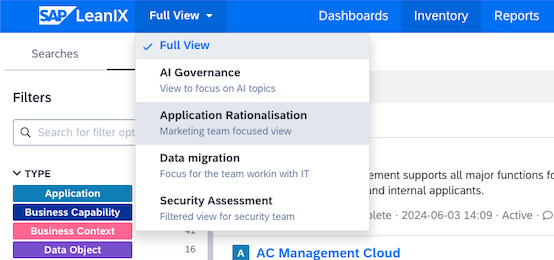Use Case Focus
Define use cases to help users efficiently work with the inventory by filtering relevant information.
Early Adopter Release
This feature is currently in early adopter release and may not be available to all customers. If you’d like to try out this feature and become an early adopter, please contact your Customer Success Manager.
Overview
Use cases provide a convenient way to filter information displayed in the inventory, which enables users to focus on specific tasks that they’re currently working on and achieve their goals more efficiently. Some common use cases include AI governance, application rationalization, migration assessment, and more.
Note
Use cases currently only apply to filtering information within the inventory. Other items such as dashboards, reports, and diagrams are not included in use cases.
As an admin, you can create use cases and define the data included in each in the Use Case Focus section of the administration area. Non-admin users can select use cases for a filtered view of the inventory, but they can’t create or modify them.
When configuring a use case, you can include specific fact sheet types in it and select specific sections and subsections for that fact sheet type. Additionally, you can enable the use case for all or specific user roles.

Use Case Focus Section in the Administration Area
Difference Between Use Cases and Virtual Workspaces
Use cases and virtual workspaces serve different purposes in managing data and user experience.
Virtual workspaces are primarily used for managing access control. They allow you to set read and write permissions for specific fact sheets, effectively limiting access to certain data for specific users. This ensures that users only access the data they need or are allowed to see. For more information, see Virtual Workspaces.
Use cases are designed to enhance user experience by setting filters for workspace data. However, use cases don't alter workspace permissions for specific users. This means while users can filter and focus on specific data, the underlying access permissions remain unchanged. Furthermore, use cases are limited to the user interface and do not extend to managing data through APIs.
Creating and Managing Use Cases
In this section, you will learn how to create and manage use cases.
Creating a Use Case
Follow these steps:
- In the administration area, navigate to the Use Case Focus section.
- Click Create Use Case Focus. You land on the page for creating a use case.
- Enter a name and, optionally, a description. This information will be visible to users when selecting a use case.
- Under Inventory and Fact Sheets, select fact sheet types to include in the use case. For each fact sheet type, select specific sections and subsections to include.
- Under Visibility, define who should have access to the use case: all users or users with specific roles.
- Decide whether you want to activate the use case after creation or save it as draft.
- Create as Draft: The use case won't be available to non-admin users. You can test the use case before activating it.
- Create and Activate: The use case will be active and available to the specified user roles.
Once a use case is created, it appears in the use cases list in the upper-left corner of the navigation panel. You can test and edit use cases if needed.

Selecting a Use Case
Managing Use Cases
You can manage use cases in the Use Case Focus section of the administration area.
- Activating a draft use case: A use case saved as draft is not available for selection to non-admin users until activated. Before activating a use case, you can test it. Once a use case is activated, you can't mark it as draft again.
- Deleting a use case: When you delete a use case, this doesn't delete any workspace data.
Example Use Cases
Here are some example use cases along with recommendations on the data to include in them:
- Application rationalization: Include application fact sheets and select subsections relevant for application rationalization, such as Business Criticality & Functional Fit.
- Security assessment: Include information related to security aspects of your IT landscape and make the use case accessible to relevant user roles, such as security officers.
- Focus on an initiative: Include information related to an ongoing initiative.
- Focus on the meta model changes: If you applied changes to the meta model configuration, create a use case focused on these changes. This enables users to fill in only relevant data.
- AI governance and adoption: Include information related to AI aspects of your IT landscape. Select the following fact sheet types and sections within them:
- Application: Information and Governance sections
- IT component: Information and Sourcing sections
- Business capability: Information section
Updated about 1 month ago
